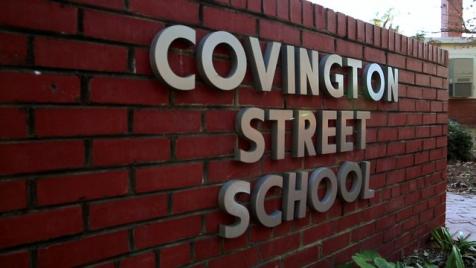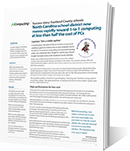CASO DE ÉXITO
North Carolina school district now moves rapidly toward 1-to-1 computing at less than half the cost of PCs
Laptops: ‘Not a viable option’
In recent years, the state of North Carolina announced ambitious goals to achieve one-to-one computer access for all its K-12 students and putting all assessment testing online. It’s a directive that’s tough for nearly any school’s budget, but even more so for Scotland County Schools.
Mostly rural, Scotland County, North Carolina, is one of the smallest counties in the state and the 16th poorest district in the nation. The 14 public schools within the county serve 6100 students. Only one third of their students have Internet access at home and many don’t have computers.
For several North Carolina districts, the answer has been funding laptops largely with grant funding. Yet after laptops are in place, those schools must pay for continuous repair and maintenance, and again find funds for replacement a few years down the road. For Rick DeLaunay, director of technology at Scotland County Schools, laptops were simply not an option.
“If I had endless pockets, I would love to go with laptops,” DeLaunay said. “But there’s a huge upfront cost and then upkeep – like replacing batteries, or replacing units that are lost or stolen. Laptops were just not a viable option for us.”
High performance for less cost
In the search for an alternative, DeLaunay discovered NComputing as the answer to accomplishing the objectives of one-to-one computing and online assessment testing – for dramatically less. NComputing employs thin client technology to enable virtualized desktops. But unlike traditional thin client technology, NComputing delivers better user performance at a lower cost.
“With NComputing, I can make a school one-to-one at a very reasonable cost, and when it’s time for a tech refresh, the costs are minimal compared to any other solution. This should be the only way it’s done,” DeLaunay said.
As a pilot, Scotland County deployed NComputing X550 units at Covington Street Elementary in Laurinburg. The X-series taps the unused capacity of a PC or server so that users can simultaneously share a single computer. With the X550s, Scotland County Schools runs five Windows workstations off a single server.
Each student has his or her own ID and password, and their own specified applications, files and settings. Teachers and students can choose from a number of applications for independent, group learning or tests.
“Every kid has a terminal to access the Internet or their applications. Anytime they go to the classroom, there’s a Windows terminal waiting for them. It’s one-to-one computing for literally pennies on the dollar,” DeLaunay said.
With success at Covington, Scotland County Schools has rolled out NComputing to every school in the district for a total of 1400 seats. And soon, Covington Street Elementary will become the first virtualized one-to-one elementary school in North Carolina.
Boosting student achievement, behavior
In district classrooms with a Windows terminal for every student, teachers have reported dramatic changes. During computer time, students work at their own pace, solving the age-old dilemma of trying to teach children that are on different paths of a learning curve. The result is more individualized learning and more focused, interested students – an experience that drives a host of other benefits.
“The student’s math assessment scores, their problem-solving, how they attack problems is so different from the other classrooms. I know it has to be because of this since it is the only thing that is different from other classrooms.” said Monica Dubbs, a first grade teacher at Covington Street Elementary and one of the first to try the NComputing solution.
“Student engagement went straight up. Discipline problems went straight down. Achievement is just awesome. It’s unbelievable what the kids have learned just having that exposure to the World Wide Web and software programs that can remediate as well as accelerate,” said Sandra Wilcher, principal at Covington Street Elementary.
Saving half a million every four years
Without the efficiency of NComputing, Scotland County Schools would not be where it is today on its journey toward one-to-one computing. DeLaunay provides one-to-one access for less than half the cost of a desktop computer.
Now with NComputing M300 units, the district will increase the number of Windows workstations possible per server and can truly power a full classroom with just one server or desktop computer.
“One server or desktop computer runs an entire classroom, and in four years when it’s time for a refresh, it will cost less than $1100 to upgrade an entire room. Plus, I’m cutting down on heat and power,” Delaunay said.
Additionally, DeLaunay and his team spend much less time troubleshooting computers. Scotland County Schools can set up three classrooms in a single day. When one server goes out, in 15 minutes they can replace it with a hot spare that’s already configured.
“If a school has 16 classrooms, then it only has 16 computers. My techs have a lot more free time on their hands. Once I get them established and working I never hear from them again. It works!” Delaunay said. “If my high school went full blown with laptops or desktops, I would have to hire probably at least one or two more techs per school just to cover that many machines. Now I don’t.”
As funding becomes available, Scotland County Schools plans to achieve one-to-one computing at the high school. With the M300 units, the cost is estimated at $266 per Windows workstation. In four years, refreshing those 1,800 Windows workstations will only cost $33 each.
“We save half a million dollars every four years and that’s not counting replacing the batteries, power supplies and lost and stolen devices we would otherwise have. And my staff doesn’t have to repair 1,800 individual computers. It’s a win-win,” DeLaunay said.
Suggested reading





